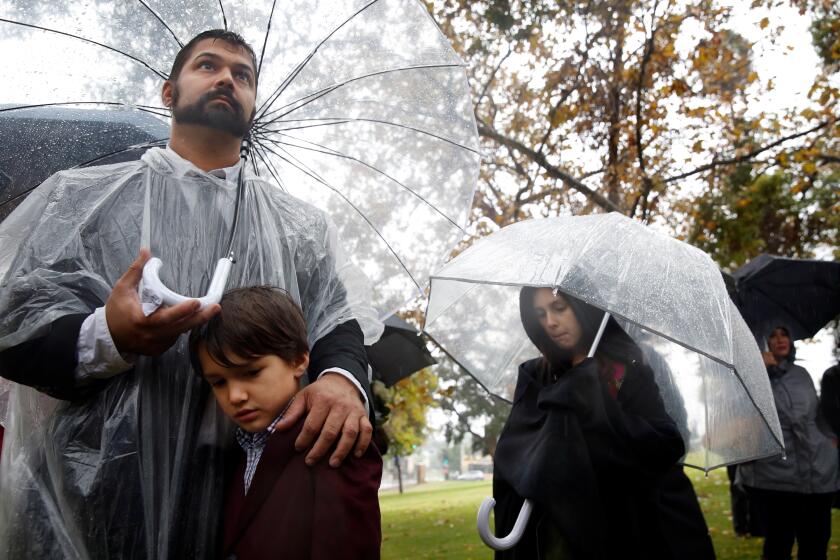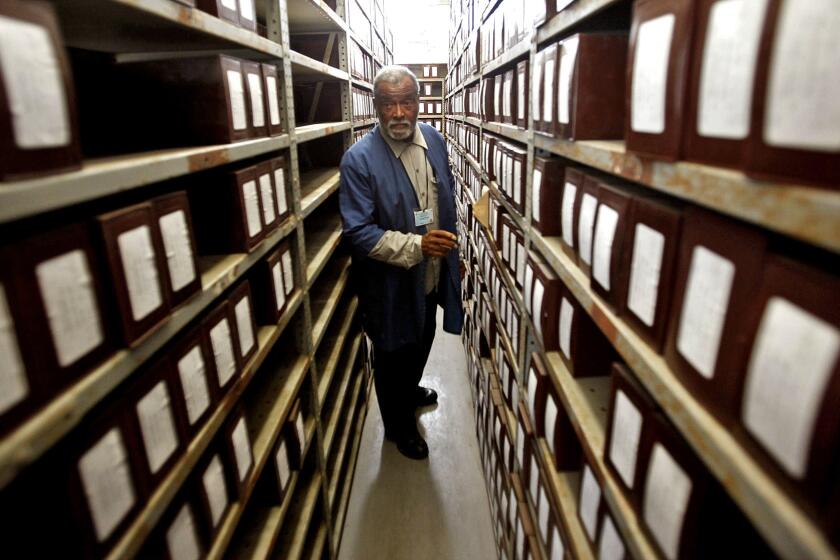As COVID-19 restrictions keep public away, Los Angeles mourns unclaimed dead in annual event

A tradition in Los Angeles to honor the burial of the county’s unclaimed dead that began in 1896 was held online for the first time Thursday, due to the pandemic.
- Share via
On Thursday morning, a handful of clergy members and Los Angeles County officials gathered on a scrubby grass hill in a Boyle Heights cemetery to memorialize the county’s unclaimed dead.
The group had come together, as L.A. County Health Services Department director Dr. Christina Ghaly said while opening the service, “with the single bond of recognizing the value and dignity of every single human life.”
“These 1,547 individuals mattered,” Ghaly continued, referencing the men, women and children whose earthly remains had been cremated by the county, and whose ashes now lay in a mass grave in Los Angeles’ oldest cemetery. The practice dates back to 1896, when L.A. County first began burying its indigent and other unclaimed bodies.
County officials hold on to the cremains of unclaimed individuals for three years, waiting for someone to claim them and reimburse the county for its services. If the ashes are not picked up, the county buries them together in a single pauper’s grave. The 1,547 being remembered and buried this year died in 2017.
Most of the people who attended Los Angeles County’s ceremony Wednesday for the unclaimed dead didn’t know each other, much less the 1,457 individuals buried together at the Boyle Heights cemetery under the plaque marked 2016.
The annual ceremony typically draws hundreds of people, who put aside work, school and familial responsibilities on a weekday morning in December to publicly mourn people they do not know.
But, like most everything else in 2020, the public service was canceled this year because of the coronavirus. The county instead chose to stream its drastically reduced service as a virtual remembrance over Facebook.
Nearly nine months into a pandemic that has brought unrelenting loss and put the holes in our social safety net on full display, roughly 200 people paused their mornings to watch the service live through their phones and computer screens. Facebook users occasionally entered comments to pray for the souls of the dead and to thank others for bearing witness.
Jorge Orozco, CEO of Los Angeles County + USC Medical Center, said those being buried were people who had “largely been forgotten by our society.”
Orozco challenged those watching to do what they could to address issues such as homelessness, poverty and racial injustice, so that someday ceremonies like this would no longer be necessary.
A few religious leaders spoke, praying in various languages and faith traditions that the dead be granted the things that may have eluded them in life — deliverance from darkness, perfect rest and sheltering refuge.
Clear shipping tape covers the oversized ledger, holding together the corners.
Between each speaker, an adolescent boy in blue surgical gloves sanitized the podium and microphone, his neatly gelled hair glinting in the sun as he worked.
After an aching rendition of “Amazing Grace” performed by a masked violinist and singer, the Rev. Elizabeth Gibbs Zehnder stopped to give thanks for the 1,547 departed souls.
“This is where they lived and laughed. They worked. They worshipped. They played. They fought and they made up. … As we prepare to make our way in this world, we carry them with us,” she said.
More to Read
Sign up for Essential California
The most important California stories and recommendations in your inbox every morning.
You may occasionally receive promotional content from the Los Angeles Times.













